This article originally appeared in the February 2021 issue of Growing For Market Magazine.
Project resurrects heirloom collards
Kale has been trendy for a while and nutritious and tasty for centuries. Collards are now in the limelight. The inaugural Collards Week in January was part of The Heirloom Collard Project. Michael Twitty, Ira Wallace, Jon Jackson, Amirah Mitchell and Ashleigh Shanti led online presentations celebrating collards, including food history, seed stewardship, gardening, farming, and cooking.
I’ve gotten excited about preserving the genetic diversity of open-pollinated crops, even though I also grow hybrids when the productivity and reliability are superior. There are very fine open-pollinated collards, so, I see no reason to look for hybrids. This rise in interest in heirloom varieties provides an income opportunity for market growers and seed growers.
The Collards Tour and book
A team of four crisscrossed the South, mostly in the Carolinas, from 2003 to 2007, searching for heirloom collards by word-of-mouth, spotting them while driving, reading newspapers, attending small-town collard festivals, buying local seed in hardware stores and eating at restaurants where collards were served. After the trip, USDA Plant Geneticist Mark Farnham grew out more than sixty of the 90 collected heirloom collard landraces (varieties) in a trial garden at a USDA Agricultural Research Station. He published several papers, including the 2007 article “Neglected Landraces of Collard from the Carolinas.”
Two other road trip members, Edward H. Davis and John T. Morgan of Emory & Henry College in Virginia, wrote a beautiful book: Collards: A Southern Tradition from Seed to Table (2015) to tell the stories of these varieties and the gardeners who preserve them. Davis and Morgan noted that despite some diversity among the collard seed savers, most were older, averaging 70, and most lacked family, friends, or neighbors willing or able to keep growing their particular family collard variety into the future.
Davis and Morgan wrote about the kale and collards divide, a sort of “Greens-shed.” The “collard belt” stretches through the South from Virginia down to Georgia and west toward Louisiana. North and west of the line, people eat more kale than collards. Collards, like kale, are non-heading brassicas. Collards are more heat tolerant than kale (helpful in a changing climate).
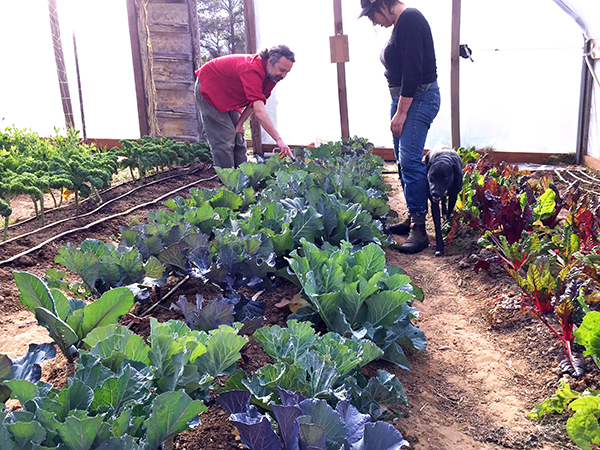
The Heirloom Collard Project
Ira Wallace’s article, “A Southern Food Tradition: Saving Heirloom Collards,” in the January/February issue of Grit magazine, points out that because giant seed companies are buying out smaller ones, the number of open-pollinated collard varieties readily available has been reduced to five. Saving heirloom collards is an act of food heritage. Wallace’s article also includes collard stories and directions for growing seed. You can also find good instructions for growing seed in Jeffrey McCormack’s article, “Brassica Seed Production: An organic seed production manual for seed growers in the Mid-Atlantic and Southern U.S.”
In 2016, Seed Savers Exchange in collaboration with Wallace at Southern Exposure Seed Exchange requested over 60 rare heirloom collard varieties from the USDA Agricultural Research Service National Plant Germplasm System (NPGS) to trial at Seed Savers Exchange in Iowa. The Heirloom Collard Project supports heirloom collards traditions by finding growers and sharing the seeds nationally and celebrating stories associated with heirloom collards. The project is building a coalition of seed stewards, gardeners, farmers, chefs and seed companies to preserve heirloom collard varieties and their culinary heritage.
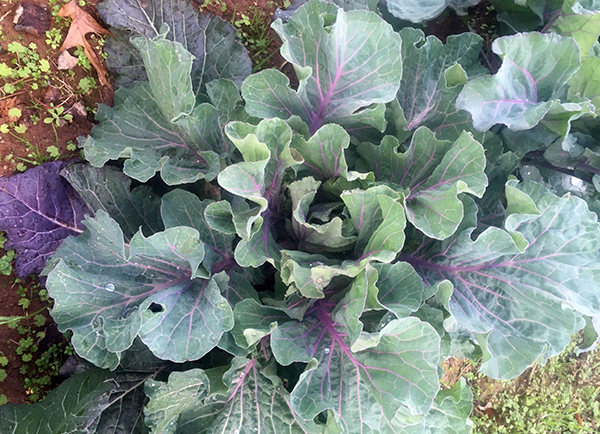
Nancy Malone Wheat Purple collards. Photo by Chris Inhulsen.
The Heirloom Collard Variety Trial
The national Heirloom Collard Variety Trial was launched last year. More than 230 participants across the country are growing 20 different varieties from the large collection at Seed Savers Exchange and the NPGS. Germplasm within the NPGS can be requested through the Germplasm Resources Information Network (GRIN).
The trials include some from the Davis and Morgan collecting trips. There are eight full trial sites, and hundreds of community scientists growing randomly selected sets of three varieties for comparisons. The growers record data on germination, uniformity, appearance, flavor, vigor, disease resistance, earliness, yield and winter hardiness. The data are recorded and analyzed via the web platform SeedLinked, which includes photos of trial varieties and farms. Join the Seed Savers Exchange and support The Heirloom Collard Project by becoming a seed saver and stewarding an endangered variety. Or simply choose a few varieties you like and grow them for sale or your own kitchen.
Growing collard greens
Collards are very easy to grow and harvest, providing months of harvests from a single sowing. They come in a wide range of leaf shapes and colors, including variegated. They are cold-hardy and heat-tolerant, with harvests for up to ten months in most regions. In zones 6 and cooler, a spring sowing can grow through the summer. Pull off ragged leaves and wait for new ones in the fall. Protection for mid-winter harvests may be needed. In zones 7 and warmer, plants grow through the winter and regrow in the spring. Hot areas may need a summer break. Value-added sauerkraut can extend the season.
Varieties and types
Some collards are referred to as “heading” or “cabbage collards,” including our favorite “Morris Heading.” These produce loose heads like Brussels sprouts as well as a full complement of leaves. The heads are cut in January in Virginia before hard freezes ruin them for cooking or a batch of kraut. “White Mountain Cabbage Collard” can grow a head the size of a football, reports Rodger Winn of South Carolina.
The range of colors includes “Alabama Blue” and “Old Timey Blue,” which are beautiful and sweet after a frost. Walt Childs in Florida grows variegated collards. The white variegation appears when winter sets in. “Carolina Yellow Cabbage Collards” are an old variety from eastern North Carolina. They’re a paler green, not really yellow. They are more tender than regular collards with a milder flavor.
Among the more common open-pollinated collards, “Vates” has high yields, bolt-resistance, cold- tolerance and uniformity. It is a relatively short variety with smooth leaves. “Champion” was developed from “Vates,” and is similar but slower to bolt and even higher yielding. “Morris Heading” has savoy leaves and tolerates heat and cold. “Georgia” is faster to mature than those just mentioned, is tolerant of a range of conditions, but faster to bolt.
Among hybrid varieties, “Flash” is uniform, high yielding and bolt-resistant, with smooth leaves on a short upright plant. It performs well in a wide variety of conditions. “Top Pick” is a tall plant with savoyed leaves, slow to bolt and highly productive. “Blue Max” (also known as “Hi Crop”) has the most cold tolerance of any I’ve heard about and is also high yielding.
Sowing
Collards may be direct sown or transplanted. Soil temperatures of 41˚F (5˚C) to 95˚F (35˚C) will work. The best temperature is 77˚F (25˚C) and seedlings take four days to emerge. There is no heat dormancy with brassicas as there is with lettuce and spinach. If direct sowing, sow 1/4 to 1/2 inch (0.5-1 cm) deep, 1 to 2 inches (2.5-5 cm) apart, or station sow a few seeds every 12 to18 inches (30-45 cm) and thin after emergence (transplanting to fill any gaps). For a fall crop, sow seeds about 80 days before frost.
Final plant spacing should be 12 to 18 inches (30-45 cm). Rows can be up to 36 inches (1m) apart, although we plant three rows equidistant on a 48-inch (1.2 m) top bed, and they thrive. Well-drained fertile soil is best.
Transplanting
Collards transplant very easily, whether from plug flats, open flats or as bare root plants (ones started in a nursery seedbed outdoors and dug up and moved later). The ideal transplant size for all brassicas is five true leaves. This could be a six-to-eight-week-old transplant in early spring or a three-week-old one in late summer.
Transplants need good watering in hot weather until established and then steady watering throughout growth to foster good flavor. We transplant because we grow lots of brassicas and freeing beds to grow non-brassicas for another month helps our rotation and pest management.
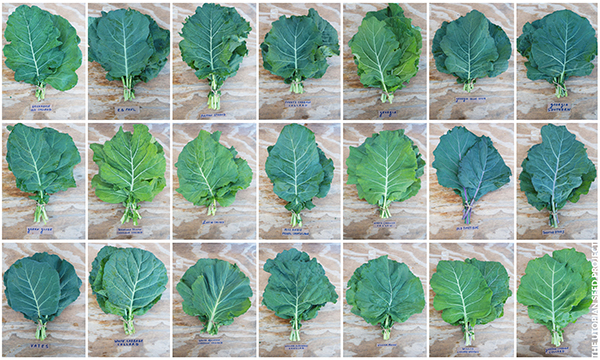
A mosaic showing the variation in leaves from 21 different heirloom collards. Photo by Chris Smith.
Caring for the crop
Plan ahead for the crop protection you need. In cold spring weather, this might be thick row cover for a few weeks until the weather gets milder. Even if not required to keep the plants alive, it will speed up the growth rate. In cold regions, you could bring back the row cover in the late fall to extend the harvest period.
Organic mulches can help keep the soil cooler and damper in summer and control weeds. In hot weather shade cloth will be useful, especially for new transplants. If you are going for a long harvest season, you might top dress at some point.
Pests and diseases
Kaolin clay can keep some pests from taking bites. We grow our summer brassica seedlings and transplants under ProtekNet netting on hoops. On the Dubois Agrinovation website study the details. Be sure to choose the right size mesh for the bugs you want to exclude.
For protection from flea beetles, use row cover or small mesh netting, 0.35mm x 0.35mm. To remove aphids, try water jets, ladybugs or soap spray. For caterpillars (cabbage worms), use Bt (Bacillus thuringiensis). “Green Glaze” is a shiny collard variety that naturally repels caterpillars. Harlequin bugs are tough to deal with organically. Netting works to keep them off. Cleome growing nearby can work as a trap crop. Collect the bugs off of the flowers by brushing them into a bucket.
A 40 percent or 50 percent knitted shade cloth that reaches the ground will keep out larger pests such as loopers and armyworms. Use brands with wide holes, not monofilament. This research has been pioneered by Ayanava Majumdar at Alabama Cooperative Extension Service. Fungal diseases can lead to spotty leaves, which should be removed as soon as possible to keep the disease under control. Neem oil may help.
Season extension/over-wintering
The winter-kill temperature for collards varies from one variety to another. Most collards die between 12˚F (-11˚C) and 10˚F (-12˚C). “Morris Heading” can survive at least one night at 10˚F; some collards such as “Blue Max” hybrid can survive down to 0˚F (-18˚C).
Succession sowings are less important because collards provide multiple harvests from one sowing. We make sowings in both spring and fall in the mid-Atlantic. The art is to time new plants so they’re ready when your old ones will bolt.
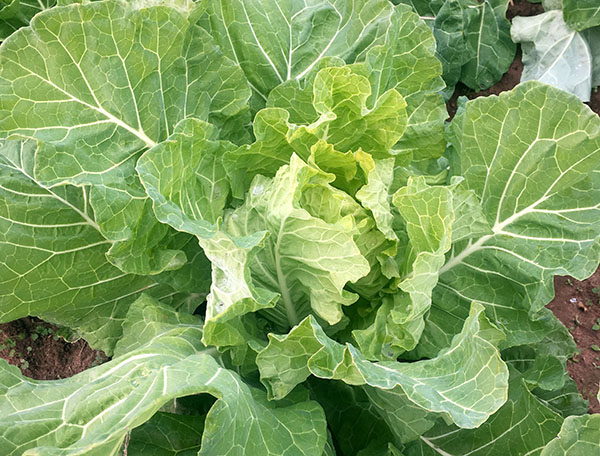
Georgia Cabbage Collards. Photo Southern Exposure Seed Exchange.
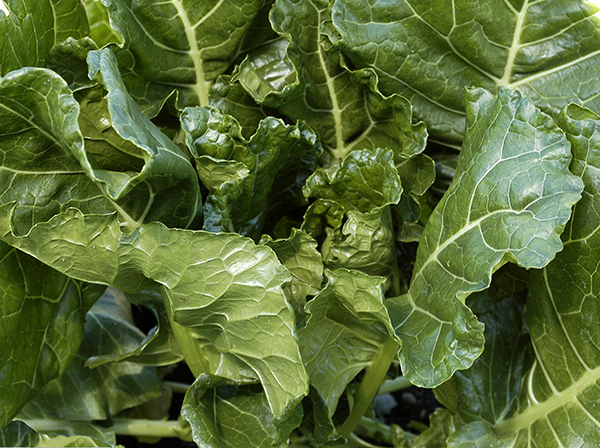
Green Glaze Collards. Photo by Airy Acorn.
Harvest
Expect to start harvesting leaves 55 to 75 days after transplanting. The flavor is sweeter after a couple of fall frosts. Some growers cut the whole plant, but most harvest individual leaves. Snap off and bunch the lower leaves, discarding unattractive ones or humungous ones larger than 12 inches (30 cm). Collards are an “insurance crop,” that can be harvested when you need to and almost ignored when you don’t need them. Summer chard is my poster-crop for this title.
As with most leafy greens, we follow an “Eight for Later” rule: when harvesting always leave at least eight inner leaves to replenish the plant and provide future harvests. If the plants are very healthy and abundant, you could sometimes leave only six. This is a sustainable harvest level. Depending on the rate of regrowth, expect another harvest in about a week. If you want to harvest a bed three times a week, plant three beds and have a harvest rotation where you pick one bed each harvest day.
There is not a precise temperature that causes bolting. The interaction of plant size (age) and cold temperatures makes the plant flower. Older plants are more likely to bolt than young plants at the same cold temperature. Young hardened-off plants are very resistant to bolting. Bolting susceptibility varies between varieties.
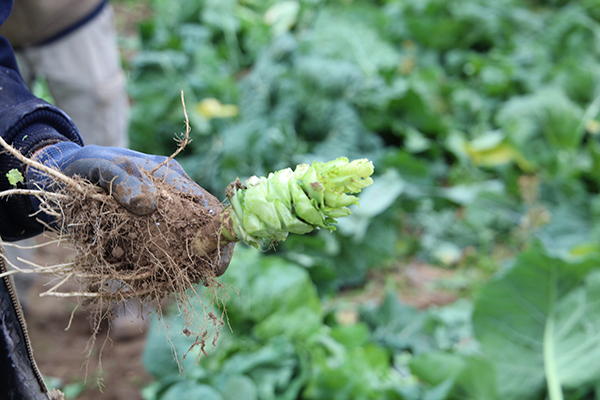
A collard steckling prepared to overwinter for seed next year. Photo by Seed Savers Exchange.
Growing collard seed
Collards are a biennial seed crop, not producing seed until after a winter. This simplifies the seed growing, as you don’t need to worry about collards crossing with any other Brassica oleracea during the first season. To grow seed, keep your collard plants alive over winter. If you can’t do this outdoors or in a hoophouse, dig up the plants in late fall and trim off the leaves, preserving the growing point. Pack these plant stubs (called stecklings) close together in a tub of soil or even damp sawdust, to replant in early spring.
Collards require 10 to 12 weeks of vernalization — temperatures below 50˚F (10˚C) — to bolt (produce seed). Winters in zones 10 and warmer may not be cold enough for that length of time. Put tubs of stecklings in a refrigerator.
The second season you can grow other B. oleracea (cabbage, cauliflower, kohlrabi, Brussels sprouts, some kales), as long as you don’t let them flower within ½ mile (0.8 km) of your seed crop. Some kales (Russian, Siberian types) are Brassica rapa and do not cross-pollinate. I wrote about Clif Slade’s hoophouse collard seed success in my article about dry seed processing in the September 2020 issue of Growing for Market.
If you are only growing seed for your own use, as few as five plants may be enough, although 12 or more will provide more genetic diversity. For commercial sale, grow at least 80 plants.
Collards get large during seed production, so if you kept your plants outside overwinter, you may need to remove alternate plants to make space. The flower stalks can reach five to six feet (1.5-2m) high, and will need staking to keep them up. The flowers need to be pollinated by bees, wasps or flies.
The seed pods, called siliques, turn tan or pale brown as they dry. Harvest them before they begin to split and scatter your seeds. Put the harvested pods, stems, or whole plants on a tarp or in barrels to catch the seeds as they dry. Keep the seed heads dry. After five to seven days, when the seed is too hard to dent with your fingernail, they are ready to thresh and winnow. Mature seeds are dark brown. Thresh by beating the stems of pods against the inside of the barrel, and then winnow or screen to clean the seed.
Nutritional value & health benefits
Collards are low in saturated fat and cholesterol. They are a good source of protein, vitamin E, thiamin, niacin, magnesium, phosphorus, potassium, vitamin A, vitamin C, vitamin K, riboflavin, vitamin B6, folate, calcium, iron, manganese and a very good source of dietary fiber.
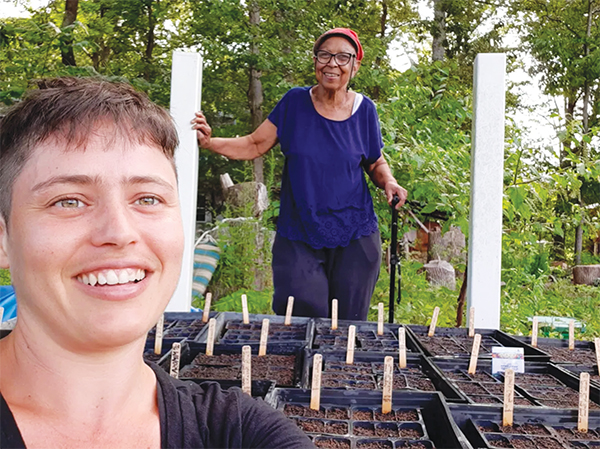
Ira Wallace (back) and Rejoice (foreground) setting up one of the full Heirloom Collard Variety Trials at Seed Savers Exchange in Iowa. Photo by Seed Savers Exchange
Cooking
I don’t generally include cooking instructions in my articles, but for collards it’s important to get it right. You might pass this information on to your customers if your market is north of Virginia or your area has a lot of newcomers or new cooks. Tender young collard leaves can be lightly steamed. Larger leaves need slower cooking. Sadly, collards have gotten a bad name in some circles. When inexperienced cooks quick-steam or flash-braise the sturdier leaves, they serv up very chewy vegetables. I asked various good cooks in Virginia to explain their methods.
Brittany’s traditional eastern NC style collards
“Boil for a very long time with a ham bone definitely and possibly a sweet potato. Some people add liquid smoke. Many hours. It should be limp. Have a bottle of vinegar and possibly Texas Pete hot sauce or vinegar with peppers on the table. This is how everyone in my family does it.”
Ira’s approach: Quick Southern Style Collards
“As an heirloom gardener I strive to keep up old fashioned food traditions while updating them to be more sustainable and healthy for our lifestyle. I prefer my collard greens young, tender and quick cooked with garlic or onions and a little vinegar or hot sauce for added zing.
1 to 2 tablespoons olive oil
1 diced sweet onion
1 to 2 bunches tender collard greens, well washed, stems removed and chopped
1/2 cup rich savory broth or ¼ cup vinegar (optional 1 teaspoon crushed red pepper flakes)
Kosher salt and freshly ground black pepper
Directions: Coat the bottom of a large cast iron skillet with the olive oil then add the onion and cook until softened, five to seven minutes. Add the chopped collards to the pan along with the broth or vinegar, optional red pepper flakes and some salt and pepper and cook until tender, but still bright green, four to five minutes. Adjust the seasoning if necessary. Serve with hot sauce and vinegar at the table.”
Madge’s favorite way of cooking and eating collards:
“De-stem the woody parts, tear the collard leaves into small pieces, double wash, and then chop the remaining stems into bite size pieces. Mince ample garlic. Lightly cook the chopped garlic with olive oil, salt, and a small amount of water. Add the stem pieces first. Cook for a few minutes. Add the collard pieces. Toss frequently. Cook until done (5 minutes—more or less—depending on the time of year). Eat. Eat. Eat!”
Collards kraut from Elli from North Carolina Folklife
“Pack a quart jar with collards, add 1 tsp of salt. Fill with water, place lid on loosely — it will seal naturally. Check on the lid in a day or so for a seal and just tighten. Let ferment for at least a month, but like with anything you ferment the longer the better.”
Collard greens slaw by Marwin Brown from Food Fidelity
Go to the website for the quantities, the whole story and more.
1. Combine shredded cabbage, collard greens, feta, red onions and chopped green onions in a large bowl.
2. In a separate bowl whisk together vinegar, olive oil, lime juice, salt, pepper, and sugar. Pour over the slaw and toss.
3. Refrigerate until ready to serve. Taste and season as necessary.
Pam Dawling works in the 3.5 acres of vegetable gardens at Twin Oaks Community in central Virginia. Her books, “Sustainable Market Farming: Intensive Vegetable Production on a Few Acres”, and “The Year-Round Hoophouse”, are widely available, including at sustainablemarketfarming.com, or from Growing for Market. Pam makes presentations on vegetable growing topics, does other teaching and consultancy. Her weekly blog is on her website and on facebook.com/SustainableMarketFarming.

